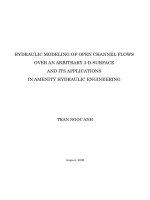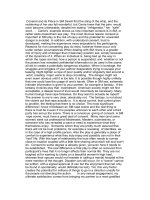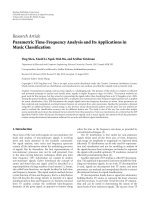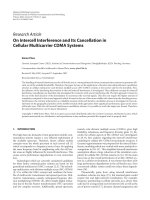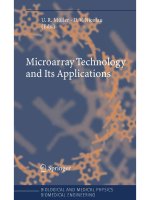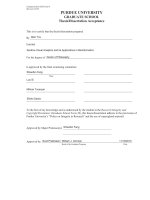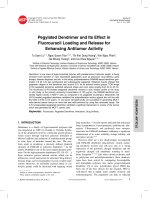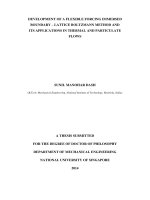nfall forecasting and its applications in flood early warning systems
Bạn đang xem bản rút gọn của tài liệu. Xem và tải ngay bản đầy đủ của tài liệu tại đây (4.4 MB, 295 trang )
RAINFALL FORECASTING AND ITS
APPLICATIONS IN FLOOD EARLY
WARNING SYSTEMS
HE SHAN
NATIONAL UNIVERSITY OF SINGAPORE
2011
RAINFALL FORECASTING AND ITS
APPLICATIONS IN FLOOD EARLY
WARNING SYSTEMS
HE SHAN
(B.Eng., Hohai University; M.Eng., Wuhan University)
A THESIS SUBMITTED
FOR THE DEGREE OF DOCTOR OF PHILOSOPHY
DEPARTMENT OF CIVIL ENGINEERING
NATIONAL UNIVERSITY OF SINGAPORE
2011
ACKNOWLEDGEMENT
I would like to express my sincere appreciation to my supervisor, Associate Professor
Liong Shie-Yui, for his continuous encouragement and guidance given to me, and his
patience throughout the whole Ph.D period.
I am also very grateful to my colleagues at Tropical Marine Science Institute
(TMSI) for their assistance and warm-hearted help, in particular to Dr. Srivatsan
Vijayaraghavan for introducing and guiding me on Numerical Weather Prediction
model, Weather Research and Forecasting (WRF); Dr. Nguyen Ngoc Son and Dr.
Doan Chi Dung for their assistance in the weather nowcasting model, Translation
Model (TM). Other colleagues at TMSI who have also been very helpful, one way or
another, and for their camaraderie are Ms Liew San Chuin, Mr. Vu Minh Tue, Mr.
Nguyen Tam Chinh, and Ms Cui Chun.
My thanks also go to SOBEK experts from Deltares especially Senior Specialist
Adri Verwey, Janjaap Brinkman and Jaap Zeekant for introducing me to the SOBEK
software; this led me to explore this model further.
I also wish to acknowledge my deepest appreciation to Tropical Marine Science
Institute which has been the main financial supporter throughout the study period.
Other financial supporters, equally appreciated, are National University of Singapore
(with its Research Scholarship) and Singapore-Delft Water Alliance (under ―MultipleObjective Multi-Reservoir Management‖ project).
i
ii
TABLE OF CONTENTS
ACKNOWLEDGEMENT ........................................................................................... I
TABLE OF CONTENTS ......................................................................................... III
SUMMARY .............................................................................................................. VII
LIST OF TABLES .................................................................................................... IX
LIST OF FIGURES .................................................................................................. XI
CHAPTER 1
INTRODUCTION........................................................................................................ 1
1.1
Overview ·········································1
·········································
1.2
Objectives and Scope ··································
·································6
1.3
Contents of the Study ·································
································ 10
CHAPTER 2
NUMERICAL WEATHER PREDICTION ............................................................ 12
2.1
Introduction ·······································
······································ 13
2.2
The early history of NWP Model·························· 16
··························
2.3
NWP formulation ··································· 17
···································
2.3.1
Model equations ........................................................................................... 18
2.3.2
Parameterization of physical process ........................................................... 22
2.4
Advantages and challenges ······························
····························· 22
2.5
Forecasting review···································
·································· 24
2.6
Weather Research and Forecasting Model ·····················
···················· 25
iii
2.6.1
Introduction .................................................................................................. 25
2.6.2
WRF Forecasting and Parameterizations Sensitivity Review ..................... 27
2.6.3
Data Source .................................................................................................. 31
2.6.4
Singapore Case Study .................................................................................. 33
2.6.4.1
Model Parameterization sensitivity...................................................... 35
2.6.4.2
Model domain design sensitivity ......................................................... 40
2.6.4.3
Model resolution sensitivity................................................................. 41
2.6.4.4
Multiple Nesting Sensitivity ................................................................ 42
2.6.4.5
Time series comparison: WRF versus Station data ............................. 44
2.6.4.6
Long-term WRF Hindcast: North-East Monsoon Season ................... 46
2.6.5
Conclusion ................................................................................................... 48
CHAPTER 3
RAINFALL NOWCASTING MODEL: TRANSLATION MODEL.................... 90
3.1
Introduction ·······································
······································ 90
3.2
Translation Model ···································
·································· 93
3.2.1
Governing Equations ................................................................................... 93
3.2.2
Identification of translation vector ............................................................... 94
3.2.3
Quadratic translation vector ......................................................................... 96
3.2.4
Re-identifying translation vector in the filtered quarter .............................. 98
3.2.5
Quantitative Precipitation Forecast Indicator .............................................. 99
3.3
Application of TM to Marina Catchment ···················· 101
····················
3.3.1
Comparison between various functions of translation vector .................... 102
3.3.1.1
3.3.1.2
3.4
Areal Average Rainfall (AAR) comparison ...................................... 102
At site comparison ............................................................................. 103
Conclusion ······································ 104
······································
CHAPTER 4
COMBINED RAINFALL FORECASTING: COUPLING TM AND WRF...... 116
4.1
Introduction ······································116
·····································
iv
4.2
Approach ······································· 118
·······································
4.3
Application, Results and Discussion ······················· 121
·······················
4.3.1
Results and Discussion .............................................................................. 121
4.3.1.1
Rainfall Event on 8th December 2008 ................................................ 121
4.3.1.2
Rainfall Event on 18th and 19th November 2009 ............................... 125
4.4
Conclusions ······································127
·····································
CHAPTER 5
RAINFALL-RUNOFF MODEL: SOBEK ............................................................ 169
5.1
Introduction ······································169
·····································
5.2
Rainfall-Runoff Model ······························· 171
·······························
5.2.1
SOBEK and Rainfall-Runoff Concept ....................................................... 171
5.2.2
Model Calibration Technique .................................................................... 172
5.2.3
Data collection and model setup ................................................................ 174
5.2.4
Calibration Results ..................................................................................... 174
5.3
Conclusions ······································176
·····································
CHAPTER 6
CONCLUSIONS AND FUTURE WORK ............................................................. 180
6.1
Research work summary······························ 182
······························
6.2
Future works ····································· 183
·····································
REFERENCES ......................................................................................................... 186
APPENDIX A
PARAMETERIZATION OPTIONS ..................................................................... 198
APPENDIX B
PHYSICS TESTING ............................................................................................... 200
v
APPENDIX C
COMPARISON OF WRF RESULTS WITH OBSERVED RAINFALL .......... 204
C-1 Tengah Station ······································205
·····································
C-2 Seletar Station ······································210
·····································
C-3 Paya Lebar Station ··································· 216
···································
C-5 Simei Station ······································ 220
······································
APPENDIX D
COMPARISON OF COMBINED RAINFALL FORECASTING WITH
OBSERVED RAINFALL ........................................................................................ 222
vi
SUMMARY
One of the important factors in reservoir management involves employment of a flood
early warning system that predicts large surface runoff before their actual arrival in a
holistic and integrated manner. For urban scales, heavy precipitation events need to be
forecast to be able to be prepared for a flash flood. This becomes more important in a
changing climate should more heavy rainfall events occur. This is in turn linked to
reservoir management. The overall objective of this study is to improve the
forecasting accuracy of the precipitation in the Singapore region by means of rainfall
forecasting and nowcasting.
The Weather Research and Forecasting Model (WRF) was applied over
Singapore and its neighboring region for rainfall forecasting. Its performance was
evaluated on various rainfall events to ensure its ability to provide credible forecasts.
A rainfall nowcasting method using a Translation Model (TM) was also applied,
which incorporates the radar measurements.
Based on the results obtained from the TM and the WRF, a combined rainfall
forecasting was constructed. Weighting factors of 0.7 and 0.3 have been used and
assigned to results from TM and WRF, respectively. Results presented in this thesis
consist of the individual results from WRF and TM and the results from the
Combined Rainfall Forecasting. The combined rainfall forecasting covered the fullspan of 24 hours forecasting by combining the WRF results and TM results to provide
an improved rainfall forecasting. Combined rainfall forecasting provides more
vii
accurate results than rainfall forecasts from a single combined member.
Finally, an urban rainfall-runoff model SOBEK was implemented to simulate the
flood and a reasonably good performance shows this model can be used for flood
forecasts.
viii
LIST OF TABLES
Table 2-1 Domain Sensitivity ..................................................................................... 50
Table 2-2 Resolution Sensitivity Tests ....................................................................... 50
Table 3-1 Four-cell contingency table ...................................................................... 105
Table 3-2 Classification of events in the forecast contingency table ........................ 106
Table 3-3 Criteria used for QPF performance indicator ........................................... 106
Table 3-4 Name of sub-catchments used in comparison ......................................... 107
Table 3-5 Names of stations used for comparison .................................................... 107
Table 3-6 QPF indicators between TM and Radar Observed for four sub-catchments
.................................................................................................................................... 107
Table 3-7 QPF indicators between TM and Radar Observed for AAR comparison in
the event from Sep 2009 to Dec 2009 ........................................................................ 108
Table 3-8 Percentage of best score among 3 approaches for AAR comparison ........ 108
Table3- 9 QPF indicators between TM and Radar Observed at some stations for lead
time 1 hour ................................................................................................................. 108
Table 3-10 QPF indicators between TM and Radar Observed at some stations for lead
time 2 hours................................................................................................................ 110
Table 3-11 QPF indicators between TM and Radar Observed at some stations for lead
time 3 hours................................................................................................................ 111
Table 3-12 Percentages of best score among 3 approaches for at-site comparison ... 111
Table 4-1 Summary of comparison of essential rainfall parameters between observed
and combined rainfall forecasting results: Rainfall Event on 8th Dec 2008 ............. 130
Table 4-2 Summary of comparison of essential rainfall parameters between observed
and combined rainfall forecasting results: Rainfall Event on 18th and 19th Nov 2009
.................................................................................................................................... 142
Table 5-1Performance accuracy of SOBEK simulated runoff compared with observed
runoff data .................................................................................................................. 178
Table A-1 Physics Options that were chosen under each category of parameterizations
.................................................................................................................................... 198
ix
Table B-1 Each case refers to the options of parameterizations available under each
category and then used a combined suite ................................................................... 201
Table D-1 Summary of comparison of essential rainfall parameters between observed
and combined rainfall forecasting results: Rainfall Event on 20th Nov 2009 ............ 224
Table D-2 Summary of comparison of essential rainfall parameters between observed
and combined rainfall forecasting results: Rainfall Event on 4th Dec 2009 .............. 225
Table D-3 Summary of comparison of essential rainfall parameters between observed
and combined rainfall forecasting results: Rainfall Event on 24th Dec 2009 ............ 226
Table D-4 Summary of comparison of essential rainfall parameters between observed
and combined rainfall forecasting results: Rainfall Event on 16th Jun 2010 ............. 227
x
LIST OF FIGURES
Figure 1-1 Top view of Marina barrage of Singapore (extracted from PUB website) 12
Figure 2-1Multiple Domain Design for test 1 with different spatial resolutions ......... 61
Figure 2-2 WRF results from four parameterization runs of Domain sensitivity test 1
over domain 2 .............................................................................................................. 62
Figure 2-3 TRMM and GPCP observed rainfall over domain 2 .................................. 62
Figure 2-4 WRF results from four parameterization runs of Domain sensitivity test 1
over domain 3 .............................................................................................................. 63
Figure 2-5 TRMM and GPCP observed rainfall over domain 3 .................................. 63
Figure 2-6 Multiple Domain Design for test 2 with different spatial resolutions ........ 64
Figure 2-7 WRF results from four parameterization runs of Domain sensitivity test 2
over domain 2 .............................................................................................................. 65
Figure 2-8 TRMM and GPCP observed rainfall over domain 2 .................................. 65
Figure 2-9 WRF results from four parameterization runs of Domain sensitivity test 2
over domain 3 .............................................................................................................. 66
Figure 2-10 TRMM and GPCP observed rainfall over domain 3: (a) TRMM; (b)
GPCP............................................................................................................................ 66
Figure 2-11 Multiple Domain Design for test 3 with different spatial resolutions ...... 67
Figure 2-12 WRF results from four parameterization runs of Domain sensitivity test 3
over domain 2 .............................................................................................................. 68
Figure 2-13 TRMM and GPCP observed rainfall over domain 2 ................................ 68
Figure 2-14 WRF results from four parameterization runs of Domain sensitivity test 3
over domain 3 .............................................................................................................. 69
Figure 2-15 TRMM and GPCP observed rainfall over domain 2 ................................ 69
Figure 2-16 WRF results from four parameterization runs of Resolution sensitivity
test 36km-12km-4km over domain 2 ........................................................................... 70
Figure 2-17 TRMM and GPCP observed rainfall over domain 2 ................................ 70
Figure 2-18 WRF results from four parameterization runs of Resolution sensitivity
test 36km-12km-4km over domain 3 .......................................................................... 71
xi
Figure 2-19 TRMM and GPCP observed rainfall over domain 2 ................................ 71
Figure 2-20 WRF results from four parameterization runs of Resolution sensitivity
test 30km-10km-5km over domain 2 .......................................................................... 72
Figure 2-21 TRMM and GPCP observed rainfall over domain 2 ................................ 72
Figure 2-22 WRF results from four parameterization runs of Resolution sensitivity
test 30km-10km-5km over domain 3 .......................................................................... 73
Figure 2-23 TRMM and GPCP observed rainfall over domain 2 ................................ 73
Figure 2-24 Multiple Nesting Sensitivity domain design with different spatial
resolutions .................................................................................................................... 74
Figure 2-25 WRF results from four parameterization runs of Multiple Nesting
Sensitivity test 10km-5km over domain 2 ................................................................... 75
Figure 2-26 TRMM and GPCP observed rainfall over domain 2 ................................ 75
Figure 2-27 Comparison between GFS and simulated WRF Sea Level pressure (hpa)
on 8th Dec 2008 ............................................................................................................ 76
Figure 2-28 Comparison between GFS and simulated WRF Wind Speed (vectors m/s)
...................................................................................................................................... 76
Figure 2-29 Locations of five rainfall stations over Singapore ................................... 77
Figure 2-30 Comparison between observed and simulated WRF rainfall data on 8th
Dec 2008 at Changi Station ......................................................................................... 80
Figure 2-31 Comparison between observed and simulated WRF rainfall data on 8th
Dec 2008 at Tengah Station ......................................................................................... 81
Figure 2-32 Comparison between observed and simulated WRF rainfall data on 8th
Dec 2008 at Seletar Station .......................................................................................... 82
Figure 2-33 Comparison between observed and simulated WRF rainfall data on 8th
Dec 2008 at PayaLebar Station .................................................................................... 83
Figure 2-34 Comparison between observed and simulated WRF rainfall data on 8th
Dec 2008 at Simei Station............................................................................................ 84
Figure 2-35 Comparison between observed and simulated WRF rainfall data on 5th
Nov 2009 at Changi Station ......................................................................................... 85
Figure 2-36 Comparison between observed and simulated WRF rainfall data on 19th
Nov 2009 at Changi Station ......................................................................................... 86
Figure 2-37 Comparison between observed and simulated WRF rainfall data on 2 Dec
2009 at Changi Station ................................................................................................. 87
xii
Figure 2-38 Comparison between observed and simulated WRF rainfall data on 18th
Dec 2009 at Changi Station ......................................................................................... 88
Figure 3-1 Radar domain, interested catchment, and rain cells ................................. 112
Figure 3-2 Global translation vector .......................................................................... 112
Figure 3-3 Portion of rain cells which may reach catchment .................................... 113
Figure 3-4 Rain cells retained to re-identify translation vector ................................. 113
Figure 3-5 Location of the sub-catchments and stations ........................................... 114
Figure 4-1 Moving nowcasting windows of TM ....................................................... 144
Figure 4-2 Moving forecasting windows of WRF ..................................................... 144
Figure 4-3 Combined Rainfall Forecasting: TM coupled with WRF at 0:00 hour .... 145
Figure 4-4 Locations of five rainfall stations over Singapore ................................... 145
Figure 4-5 Comparison between observed and simulated WRF and TM rainfall data
on 8th Dec 2008 at Changi Station ............................................................................. 146
Figure 4-6 Comparison between observed and Combined rainfall data on 8th Dec 2008
at Changi Station ........................................................................................................ 147
Figure 4-7 Comparison between observed and simulated WRF and TM rainfall data
on 8th Dec 2008 at Tengah Station ............................................................................. 148
Figure 4-8 Comparison between observed and Combined rainfall data on 8th Dec 2008
at Tengah Station ....................................................................................................... 149
Figure 4-9 Comparison between observed and simulated WRF and TM rainfall data
on 8th Dec 2008 at Selatar Station .............................................................................. 150
Figure 4-10 Comparison between observed and Combined rainfall data on 8th Dec
2008 at Seletar Station ............................................................................................... 151
Figure 4-11 Comparison between observed and simulated WRF and TM rainfall data
on 8th Dec 2008 at Paya Lebar Station ....................................................................... 152
Figure 4-12 Comparison between observed and Combined rainfall data on 8th Dec
2008 at PayaLebar Station ......................................................................................... 153
Figure 4-13 Comparison between observed and simulated WRF and TM rainfall data
on 8th Dec 2008 at Simei Station ............................................................................... 154
Figure 4-14 Comparison between observed and Combined rainfall data on 8th Dec
2008 at Simei Station ................................................................................................. 155
Figure 4-15 Comparison between observed and simulated WRF and TM rainfall data
on 19th Nov 2009 at Changi Station ........................................................................... 156
Figure 4-16 Locations of rainfall stations over Radar Image of Singapore ............... 157
xiii
Figure 4-17 Radar Image on 19th Nov 2009 .............................................................. 158
Figure 4-18 Comparison between observed and Combined rainfall data on 19th Nov
2009 at Changi Station ............................................................................................... 160
Figure 4-19 Comparison between observed and simulated WRF and TM rainfall data
on 19th Nov 2009 at Tengah Station .......................................................................... 161
Figure 4-20 Comparison between observed and Combined rainfall data on 19th Nov
2009 at Tengah Station .............................................................................................. 162
Figure 4-21 Comparison between observed and simulated WRF and TM rainfall data
on 18th Nov 2009 at Seletar Station ........................................................................... 163
Figure 4-22 Comparison between observed and Combined rainfall data on 18th Nov
2009 at Seletar Station ............................................................................................... 164
Figure 4-23 Comparison between observed and simulated WRF and TM rainfall data
on 18th Nov 2009 at PayaLebar Station ..................................................................... 165
Figure 4-24 Comparison between observed and Combined rainfall data on 18th Nov
2009at Payalebar Station............................................................................................ 166
Figure 4-25 Comparison between observed and simulated WRF and TM rainfall data
on 18th Nov 2009 at Simei Station ............................................................................. 167
Figure 4-26 Comparison between observed and Combined rainfall data on 18th Nov
2009 at Simei Station ................................................................................................. 168
Figure 5-1 Four catchments and the monitoring stations........................................... 179
Figure 5-2 Hydrograph comparisons at Geylang catchment: model calibration with
∆Qp minimized ............................................................ Error! Bookmark not defined.
Figure 5-3 Hydrograph comparisons at Geylang catchment: model validation with
∆Qp minimized .......................................................................................................... 180
Figure C-1 Comparison between observed and simulated WRF rainfall data on 5th
Nov 2009 at Tengah Station ...................................................................................... 205
Figure C-2 Comparison between observed and simulated WRF rainfall data on 19th
Nov 2009 at Tengah Station ...................................................................................... 206
Figure C-3 Comparison between observed and simulated WRF rainfall data on 27th
Nov 2009 at Tengah Station ...................................................................................... 207
Figure C-4 Comparison between observed and simulated WRF rainfall data on 28th
Nov 2009 at Tengah Station ...................................................................................... 208
Figure C-5 Comparison between observed and simulated WRF rainfall data on 27th
Dec 2009 at Tengah Station ....................................................................................... 209
xiv
Figure C-6 Comparison between observed and simulated WRF rainfall data on 5th
Nov 2009 at Seletar Station ....................................................................................... 210
Figure C-7 Comparison between observed and simulated WRF rainfall data on 18th
Nov 2009 at Seletar Station ....................................................................................... 211
Figure C-8 Comparison between observed and simulated WRF rainfall data on 19th
Nov 2009 at Seletar Station ....................................................................................... 212
Figure C-9 Comparison between observed and simulated WRF rainfall data on 26th
Nov 2009 at Seletar Station ....................................................................................... 213
Figure C-10 Comparison between observed and simulated WRF rainfall data on 2 Dec
2009 at Seletar Station ............................................................................................... 214
Figure C-11 Comparison between observed and simulated WRF rainfall data on 4 Dec
2009 at Seletar Station ............................................................................................... 215
Figure C-12 Comparison between observed and simulated WRF rainfall data on 5th
Nov 2009 at PayaLebar Station ................................................................................. 216
Figure C-13 Comparison between observed and simulated WRF rainfall data on 19th
Nov 2009 at PayaLebar Station ................................................................................. 217
Figure C-14 Comparison between observed and simulated WRF rainfall data on 2 Dec
2009 at PayaLebar Station ......................................................................................... 218
Figure C-15 Comparison between observed and simulated WRF rainfall data on 4th
Dec 2009 at PayaLebar Station .................................................................................. 219
Figure C-16 Comparison between observed and simulated WRF rainfall data on 5th
Nov 2009 at Simei Station ......................................................................................... 220
Figure C-17 Comparison between observed and simulated WRF rainfall data on 18th
Nov 2009 at Simei Station ......................................................................................... 221
Figure D-1 Comparison between observed and simulated WRF and TM rainfall data
on 20th Nov 2009 at Changi Station ........................................................................... 229
Figure D-2 Comparison between observed and Combined rainfall data on 20th Nov
2009 at Changi Station ............................................................................................... 230
Figure D-3 Comparison between observed and simulated WRF and TM rainfall data
on 20th Nov 2009 at Tengah Station .......................................................................... 231
Figure D-4 Comparison between observed and Combined rainfall data on 20th Nov
2009 at Tengah Station .............................................................................................. 232
Figure D-5 Comparison between observed and simulated WRF and TM rainfall data
on 20th Nov 2009 at Seletar Station ........................................................................... 233
xv
Figure D-6 Radar Image on 20th Nov 2009 .............................................................. 234
Figure D-7 Comparison between observed and Combined rainfall data on 20th Nov
2009 at Seletar Station ............................................................................................... 236
Figure D-8 Comparison between observed and simulated WRF and TM rainfall data
on 20th Nov 2009 at PayaLebar Station ..................................................................... 237
Figure D-9 Comparison between observed and Combined rainfall data on 20th Nov
2009 at PayaLebar Station ......................................................................................... 238
Figure D-10 Comparison between observed and simulated WRF and TM rainfall data
on 20th Nov 2009 at Simei Station ............................................................................. 239
Figure D-11 Comparison between observed and Combined rainfall data on 20th Nov
2009 at Simei Station ................................................................................................. 240
Figure D-12 Comparison between observed and simulated WRF and TM rainfall data
on 4th Dec 2009 at Changi Station ............................................................................. 241
Figure D-13 Comparison between observed and Combined rainfall data on 4th Dec
2009 at Changi Station ............................................................................................... 242
Figure D-14 Comparison between observed and simulated WRF and TM rainfall data
on 4th Dec 2009 at Tengah Station ............................................................................. 243
Figure D-15 Radar Image on 4th Dec 2009 ................................................................ 244
Figure D-16 Comparison between observed and Combined rainfall data on 4th Dec
2009 at Tengah Station .............................................................................................. 246
Figure D-17 Comparison between observed and simulated WRF and TM rainfall data
on 4th Dec 2009 at Seletar Station .............................................................................. 247
Figure D-18 Comparison between observed and Combined rainfall data on 4th Dec
2009 at Seletar Station ............................................................................................... 248
Figure D-19 Comparison between observed and simulated WRF and TM rainfall data
on 4th Dec 2009 at PayaLebar Station ........................................................................ 249
Figure D-20 Comparison between observed and Combined rainfall data on 4th Dec
2009 at PayaLebar Station ......................................................................................... 250
Figure D-21 Comparison between observed and simulated WRF and TM rainfall data
on 4th Dec 2009 at Simei Station ............................................................................... 251
Figure D-22 Comparison between observed and Combined rainfall data on 4th Dec
2009 at Simei Station ................................................................................................. 252
Figure D-23 Comparison between observed and simulated WRF and TM rainfall data
on 24th Dec 2009 at Changi Station ........................................................................... 253
xvi
Figure D-24 Comparison between observed and Combined rainfall data on 24th Dec
2009 at Changi Station ............................................................................................... 254
Figure D-25 Comparison between observed and simulated WRF and TM rainfall data
on 24th Dec 2009 at Tengah Station ........................................................................... 255
Figure D-26 Comparison between observed and Combined rainfall data on 24th Dec
2009 at Tengah Station .............................................................................................. 256
Figure D-27 Comparison between observed and simulated WRF and TM rainfall data
on 24th Dec 2009 at Seletar Station ............................................................................ 257
Figure D-28 Comparison between observed and Combined rainfall data on 24th Dec
2009 at Seletar Station ............................................................................................... 258
Figure D-29 Comparison between observed and simulated WRF and TM rainfall data
on 24th Dec 2009 at PayaLebar Station ...................................................................... 259
Figure D-30 Comparison between observed and Combined rainfall data on 24th Dec
2009 at PayeLebar Station ......................................................................................... 260
Figure D-31 Comparison between observed and simulated WRF and TM rainfall data
on 24th Dec 2009 at Simei Station ............................................................................. 261
Figure D-32 Comparison between observed and Combined rainfall data on 24th Dec
2009 at Simei Station ................................................................................................. 262
Figure D-33 Comparison between observed and simulated WRF and TM rainfall data
on 16th Jun 2010 at Changi Station ............................................................................ 263
Figure D-34 Comparison between observed and Combined rainfall data on 16th Jun
2010 at Changi Station ............................................................................................... 264
Figure D-35 Comparison between observed and simulated WRF and TM rainfall data
on 16th Jun 2010 at Tengah Station ............................................................................ 265
Figure D-36 Comparison between observed and Combined rainfall data on 16th Jun
2010 at Tengah Station .............................................................................................. 266
Figure D-37 Comparison between observed and simulated WRF and TM rainfall data
on 16th Jun 2010 at Seletar Station ............................................................................. 267
Figure D-38 Comparison between observed and Combined rainfall data on 16th Jun
2010 at Seletar Station ............................................................................................... 268
Figure D-39 Comparison between observed and simulated WRF and TM rainfall data
on 16th Jun 2010 at PayaLebar Station ....................................................................... 269
Figure D-40 Comparison between observed and Combined rainfall data on 16th Jun
2010 at PayaLebar Station ......................................................................................... 270
xvii
Figure D-41 Comparison between observed and simulated WRF and TM rainfall data
on 16th Jun 2010 at Simei Station ............................................................................... 271
Figure D-42 Comparison between observed and Combined rainfall data on 16th Jun
2010 at Simei Station ................................................................................................. 272
xviii
LIST OF SYMBOLS
a
Success (Hit)
b
Failure (Miss)
BIAS
Frequency Bias
c
False Alarm
C
Coriolis force
CC
correlation coefficient
CSI
Critical Success Index
d
Correct Rejection
D
density of the air
F
friction force
FAR
False Alarm Ratio
Fi
forecast value
F
means of the forecast value
F (t, x)
forcing function
G
gravity
M
number of subareas along the x-axis
Magreidentification
translation vector magnitude
n
amount of substance
N
number of subareas along the y-axis
xix
N
number of data considered.
Oi
observed value
O
means of the observed value
P
pressure
PC
Proportion Correct
POD
Probability of Detection
POFD
Probability of False Detection
Q
rate of heat addition
q
specific humidity
R
gas constant
r (x,y,t)
horizontal rainfall intensity distribution
RMSE
root mean square error
s
2
sF
generation (or removal) rate of
standard deviation
T
u
translation vectors of rain cells along x direction
U
constant basic or mean wind speed
ut
horizontal wind speed in x-direction
v
translation vectors of rain cells along y direction
V
absolute temperature
vector function describing the flux of
V
volume
w
rainfall growth-decay rate along its movement
xx
W
expansion
rate at which work is done by the gas on its surrounding by
x
spatial coordinate
y
spatial coordinate
z
height
scalar
dV
dt
change of velocity
du
dt
rate of change of internal energy
t
time interval of the radar observation
reidentification
translation vector direction
xxi
Chapter 1. Introduction
CHAPTER 1
INTRODUCTION
1.1 Overview
Wide Scale Floods are the most frequent natural disasters which have an impact and
most times cause serious damages on economic development, human lives and
properties, and the ecological environment. With the rapid economic development and
human engineering increasing, flood disasters have been increasing. Many cities are
often affected by rainstorms and floods. Flood forecasting has become a public
concern in many countries with high frequency and wide range of flood disaster.
Damage due to natural disasters had dramatically increased in the last decades.
Flooding is one the worst weather-related hazard, causing loss of life and excessive
damage to property. The National Oceanic and Atmospheric Administration (NOAA)
and National Research Council (NRC) stated that nearly $3.6 billion worth of
property damaged or destroyed each year in US. In addition, it has been reported that
flood damages are increasing at a rate of 5% per year (Barrett, 1983).
In Asia, floods are by far the most frequent and devastating natural disasters. The
Intergovernmental Panel on Climate Change (IPCC) has predicted significant increase
of extreme rainfalls in the next few decades due to climate changes in monsoon Asia
1
Chapter 1. Introduction
region and that is definitely going to worsen the flooding situation in Asia (IPCC,
2001). Flood disaster is one of the most damaging natural disasters in China, with
annual average losses more than 200 billion Yuan in recent years. Two-third of the
land areas are threatened by the severe floods in varying degrees, mainly in the lowermiddle section of the Yangtze River and North China, Central China, South China and
Northeast China. Bangkok is a natural floodplain due to its low elevation and
geographic location at the lower basin of the Chao Phraya River. Frequent floods have
been a big hindrance in its development. Although the Royal Thai Government has
been undertaking various measures, it has not yet become possible to mitigate the
flood disasters in this capital city and economic hub of Thailand. The rapid
urbanization and heavy soil settlement have adversely affected the flooding situation
in Bangkok. Climatic change is likely to worsen the situation. Under such
circumstances, it is urgent to develop a proper urban flood risk management strategy
for Bangkok metropolitan, which is the home to more than 10 million people. Ho Chi
Minh City has a great potential for developing industry, exports, tourism and services.
At present, however, residents of the city must confront flooding every year during
the rainy season. The city has 95 flooding-prone areas that may be caused by heavy
rain, high tide, rain and tide, poor drainage, water release by hydroelectric dams and
land subsidence combined with a global sea level rise. Flood prevention has been one
of the biggest preoccupations of Ho Chi Minh City authorities.
Singapore is a city-state with an area of about 700 km2, a population of
approximately 5.0 million people, with an annual growth of 1.9%. Singapore is not
insulated to floods, with abundant rainfall and relatively low-lying land. In the 1960s
and 1970s, floods as high as waist-level affecting large areas were common when
heavy rains came. Today, the situation has improved greatly and flood-prone areas in
2
